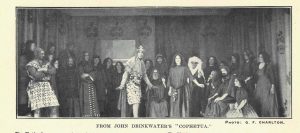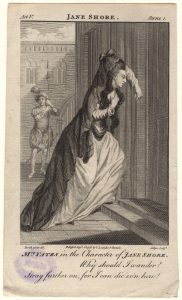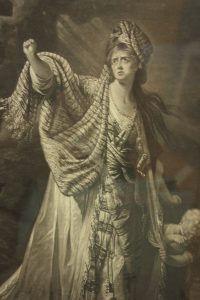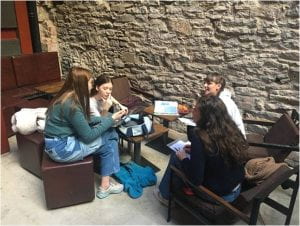Ahead of her upcoming inaugural professorship lecture on 12th of April, I met with Professor Catherine Hindson, and discussed her research on theatricality at Cadbury’s around the turn of the 20th century and beyond. Her lecture is just one of the many exciting events being held to celebrate the 75th anniversary of the Department of Theatre at Bristol.

OC: So, exactly what are you doing for this inaugural lecture?
CH: Inaugural lectures – they’re a slightly odd event, in some ways, because you’re talking to all sorts of different audiences. They’re designed to be a celebration of professorships, and, kind of, reaching that level. And you have friends and family, and I’ve got people coming from external organisations, either online or in person. And then you have fellow academics, and hopefully for me, some students, (because for me, it doesn’t mean much if students aren’t there!) listening, because you know, I am absolutely an academic who loves research and teaching in equal measure. And you talk about research you’ve been doing, but you try and weave in your life story at the same time, your professional life story, into the lecture. So it’s actually quite a challenge to write these things and pull them off.
Mine is going to be about my research that I’ve been doing for far too long, thanks to COVID and various leadership positions in the university, on theatre at Cadbury’s, and the use of theatre in that industrial community. What I’m trying to do is slightly dislodge the notion of what was going on in late 19th and early 20th century industry. It’s a controlling, paternalistic management of people through lifestyle and through professional life, but also tipping into recreation and leisure and how people live their lives. And I’m trying to dislodge that gently and suggest that perhaps there’s something going on there that was actually quite revolutionary, and innovative, and something that we could learn lessons from today. And I think we see the continuity of those lessons, actually, in companies like Google and Lego, which get a similar response from some people who, again, see this as a very controlling lifestyle. But what I’m trying to argue is that the injection of creativity into everyday working life is actually hugely beneficial to mental and physical health, and was at the beginning of the 20th century at Cadbury’s.
This book wasn’t supposed to be a book about gender – my last two books have been about gender, they’ve been about women on the popular musical stages of London and Paris and about women at the end of 19th century, actresses doing charity work to carve out social and political agency that they’re not getting necessarily through their stage careers. So this book wasn’t supposed to be about women. But it has turned out to be quite a bit about women. Because what I found out while I was doing the work is that this creativity, the combination of this focus on creativity, and recreation and education, in a Quaker-led business, led to women having managerial or leadership potential that just wasn’t really available to them in many other places in the world in the first decades of the 20th century. Because Quakers believe in a form of gender equality, they’re much more advanced around gender equality at the beginning of the 20th century than most of society. If you were a woman and working at Cadbury’s – and you didn’t get married, that was the crux of it – Then you could advance and you know, they have women sitting on their executive teams on their executive boards in the early decades of the 20th century, and a lot of these women are charged with leading on education and recreation and well-being.
I came across this community of women who were leading work and who were really pushing forward ideas around how you needed to educate and look after a workforce in order to get their full potential. And in order for society to work, really, what Cadbury’s were doing, they believe was inherently connected to the good of society, they didn’t see what they were doing as being a kind of Bournville bubble, where, only good things happen there. They saw what they were doing as feeding into government and local civic policy, around education around developing young people, around recognising that when you put a workforce into manual labour, particularly, they needed, or they believed they needed, some form of recreation and education for their brains as well. And so they were working on sort of balancing of life and well-being through that provision.
And that’s how I’m weaving that story into my lecture. I’m going to talk about leadership and my role as being a woman leader, my decisions that I’ve made throughout my professional life. I went down to four days a week, about 14 years ago, which was ferociously unpopular as a decision at the time. But it has absolutely allowed me to thrive and find my place and advance through the university into quite senior leadership positions now.
I’m going to be talking about that balance, the importance of creativity, to me the importance of people and well-being in the workplace, the importance of education and nurturing students alongside of delivering content. And I’m going to try and bring all that together with the history of Cadbury’s and women leadership there. That’s kind of what it’s going to do. And I will do that through the lens of theatre at Cadbury.
I suspect, and it’s a hunch, that people haven’t really looked for a history of theatre at Cadbury because they’ve assumed that because the Cadburys were Quakers there was no theatre. Quakers have a long strong history of anti-theatricalism, but really by the turn of the 20th century, that’s receding. So there’s a shift in Quakerism, at that time, largely, or certainly jointly, collaboratively, co-led by Cadbury and by Rowntree in York, towards something they called New Quakerism, which is a sort of a refresh on Quakerism. And an attempt to make it map on to what they see as a changing world. As part of that, they, I think really briefly, question some of the inherited ideas around what’s right and what’s wrong.
With George Cadbury in particular, I talk about it in the book, there’s some kind of documentation of his nner wrangle around dealing with the idea of theatre. He kind of finds a way through that, I think, by supporting open air theatre. He’s a really profound believer in the healthiness of fresh air – as many people are in the early 20th century – in the power of gardening, as a kind of recreational positive mental health activity as well as physical health. They have big greenhouses at Cadbury where gardening is encouraged, there are gardening clubs that you can go to as an employee. And he kind of comes around to the idea that doing theatre in the fresh air, pageant theatre, or big outdoor plays, is a way where theatre can be really clearly connected to all of the other stuff he believes in around education, recreation and health.
So there’s a history of massive outdoor plays at Cadbury with audiences of up to 3000. They built a big open-air theatre on one of the Girls’ Recreation Grounds. It’s kind of like earthworks it’s designed to be disguised. It gives us an amphitheatre that appears like it’s always been there in the ground, which I think is really important if you think about his kind of need to align theatre with nature. And then increasingly, you get theatre indoors too. So you get a big concert hall built within the factory in the 1920s. That’s still there. They built a girl’s swimming baths in the first decade of the 20th century. And someone worked out that if you drain those swimming baths and build a platform out, you’ve got a perfect indoor venue. So they do that for Christmas entertainments quite regularly. Both of these sites are still there, they’re mothballed. I was lucky enough to get into both of them although the spiders in the swimming bath were something to be seen! But you know, I did get to squidge along and try and work out how big the spaces would be.
And so you have this history of regular theatre as part of staff parties, as part of a dramatic society, which they set up in the factory in the second decade as part of education, the continuation schools where factory staff would be on day release to go – makes it sound awful, doesn’t it? – But it’s further education, and we’re talking post-14 at this point, although that changes during the period I’m talking about and becomes later. And it’s everywhere. It’s absolutely everywhere, this kind of theatricality from and about Cadbury’s.
I spent two days in the archives to start with, and went: “wow”. And then I spent the next six years researching and writing. I’ve also written a little bit in the book about Port Sunlight, which is Lever’s soap factory and village, up in The Wirral, about Rowntrees of York, as the two other kind of models from around the same time. Does that answer what it’s about? it’s really hard to condense it down. But that’s what it’s about. It’s about people. It’s about local people.
One of the things I love is that I’ve been writing about people whose stories I can unearth, through the Cadbury’s employees records and genealogical research. I’ve been pulling those two strands in to write about people who you normally wouldn’t hear about in the histories of theatre. But who, arguably, theatre had a hugely significant impact on between, say, 1900 and 1935.
OC: Wow. It just sounds fantastic. I’ve driven through Bournville before and I’ve seen those beautiful houses with the bay windows so there must have been, I believe, from reading that I’ve done, built obviously by the Quakers for the workers of a factory. I think, am I correct in thinking that?
CH: Sort of! It’s a bit of a misnomer with Bournville… Cadbury never intended Bournville to be a village just for his workers. It was a side project. It’s completely divided from the business. At least from the early 20th century, I think a little bit earlier, I need to go back and check the date. And it’s set up as a trust. He has workers from all over living in the village. Although there are some Cadbury workers who lived there, but certainly by the time I’m writing about, the number of workers in the factory massively overran the amount of house space in the village.
OC: Ah, okay!
CH: There are some connections which I talk about in the book. I talk about the Bournville Village Festival, which is a summer event every year. It’s a bit like a massive scale fete. The village council let the villagers use the recreation grounds, of which there are two massive green grass spaces in front of the factory. If you’ve driven past you’ve got that really iconic 1920s factory build. Then you’ve got a massive green space in front of it. And just over the road, there’s another massive green space. And they’re separate recreation grounds for the men and the women at that point, and so they let them use this space. As part of these festivals, they stage a children’s play every year, which is performed by children at the village schools. And the factory staff who are involved in theatre quite regularly are writing the scripts for these plays, and then are coming in, to – ‘direct’ is probably bit overblowing it – but you know, trying to produce these performances, and also sometimes to supplement the casts.
I talked about that a bit in the book as well. But the book is primarily based within the industrial boundaries of the factory. In other buildings around Bournville, like the Quaker College and The Beeches which was a big house that Cadbury transformed into a holiday space for inner-city children who were suffering from the impact of living in really unhealthy cities. There were quite a lot of charities around the turn of the 19th and 20th centuries that worked on getting these kids out of the city on a regular basis letting them run around in the front and go back to the fresh air because the fresh air is really important! You know, eating healthy local food, doing gardening, that kind of stuff. So I mean, he was an extraordinary man. Most of the book doesn’t talk about him so much, it talks about the next two generations – the rollout of Cadbury’s gameplan through the next two generations of the Cadbury family.
OC: Gosh, yeah. I love that idea of creating holiday houses for those who don’t necessarily get to go out into the countryside. I’m from the countryside myself. So I definitely appreciate the idea of getting outside and appreciating nature especially if you come from inner city it’s definitely something you don’t get to see very often.
I’ve got a couple more questions for you if that’s all right. One of them is: what was the most surprising element of your research? What was something that you really weren’t expecting to uncover whilst you were doing all this?
CH: I think the scale and the amount. I was expecting, to be honest, to write a book that looked in equal parts at Rowntree’s and Levers. So Port Sunlight, New Earswick, and Bournville. And it became really clear to me quite early on that actually, I wanted this book to be about Cadbury’s. That was partly because of the comprehensiveness of the archive, partly about having access to those employee records, and to the works magazines, the full run of works magazines, which you know, are in place at Port Sunlight and at New Earswick. But the combination of those and the employee records that I can access really easily, the material remains of the theatres, which I could get to and see and experience. And just the amount – the sheer amount – of theatre and the way that theatre was knitted in to the operation, it was really clear to me – it wasn’t something that was happening on the side – that it’s absolutely embedded right at the heart of these decades of what Cadbury’s were trying to achieve as an organisation.
And I would argue that in terms of their commercial wing as much as anything else, the way they’re playing this theatre as publicity, the way they’re pulling imagery from the firm. And from their advertising. They were incredible, as you might suspect, because they still are incredible advertisers. That kind of history of innovative catchy advertising starts at the beginning of the 20th century. That’s being pulled into the theatrical activity as well. And it just became really clear to me that there was a massive amount of stuff I didn’t expect to find going on. And then it was right at the heart, it’s absolutely entangled in the whole operation.
I think that makes it slightly different to both New Earswick and to Port Sunlight, although I’d argue that the closest comparison is New Earswick, which is interesting because, of course, it’s another Quaker firm. I’m talking with both Port Sunlight and New Earswick at the moment about rolling out some of my research in other ways with and through them either by doing talks or contributing to other projects that they’re doing. So that’s exciting.
OC: Sounds it. I really could listen to this for hours and hours.
CH: I could talk for hours so you’re alright! Haha.
OC: Funnily enough I have lived next to a chocolate factory in the past, and on a rainy morning you would be able to smell, what I thought, smelled like brownies – would you get that there?
CH: Yes. Where I was working – when I was doing research – I would stay at the Old Farm Hotel, which is really close. You’ve got the factory in the green area, you’ve got the main road coming through, and the old farm is there on the other side of the road, and it’s the oldest inn and hotel in the area. And, and yeah, you could [smell it], when I got up in the morning, it depended on the day and where they were in the production cycle. But some mornings you would get up, walk out the hotel and go. “Mmmm!” It was just delicious. And I talk about that in the book a little bit as well as a sensory experience of working there. And being in that area, because some of the press of Cadbury bring the press down from London for special visit days on the train and wine and dine them to make sure they’re getting good publicity and take them on tours around the factory. And some of the journalists talk about getting off that train and just being hit by the smell of chocolate. So yes I think it’s very similar, but it’s not every day.
OC: It’s been a pleasure to chat with you today and I’ve got one more question if that’s alright – I’d like to know what is your favourite type of chocolate? And has this changed since doing all your research?
CH: That’s a great question. I’ve got two answers to that. The first is that my favourite will always be a Strawberry Roses, which the archive team realised quite quickly and one of the benefits of working in the Cadbury archive is that there is quite a lot chocolate about so you know, Strawberry Roses will always be my chocolate of choice. But what I would really love to do is resuscitate some heritage brands that I came across when I was doing the research. By looking at some of the tableaux vivants – the performed frozen pictures staff performances included – as replications of their chocolate adverts: the stuff that’s in the press, they will then perform as tableau vivant as part of entertainment for the staff and one of the great chocolates I came across was something called the Greengage Cream. And that’s the chocolate I would like to eat. If they could just start making it again for me that’d be great.
OC: Ooh, what is in a Greengage Cream?
CH: Greengage – you can buy greengage jam, my Gran used to make it, and it’s closest fruit is a plum. I’d need to check that it’s got a kind of plummy taste to it, but it’s slightly sharper. It’s plum sized and green. And so it’s the equivalent of a Strawberry Roses but with a greengage filling.
OC: Very nice.
CH: So, Strawberry Roses are the ones I can get. Greengage Creams are the ones I’d like to eat.
OC: If you could!
CH: I can really confidently answer that question! Haha.
Professor Hindson’s inaugural lecture takes place on 12th April 2023 at 2pm in 43 Woodland Road. Everyone is warmly invited to learn more about this fascinating time for chocolate and theatre!







